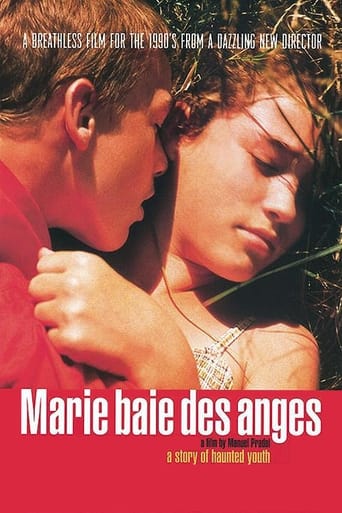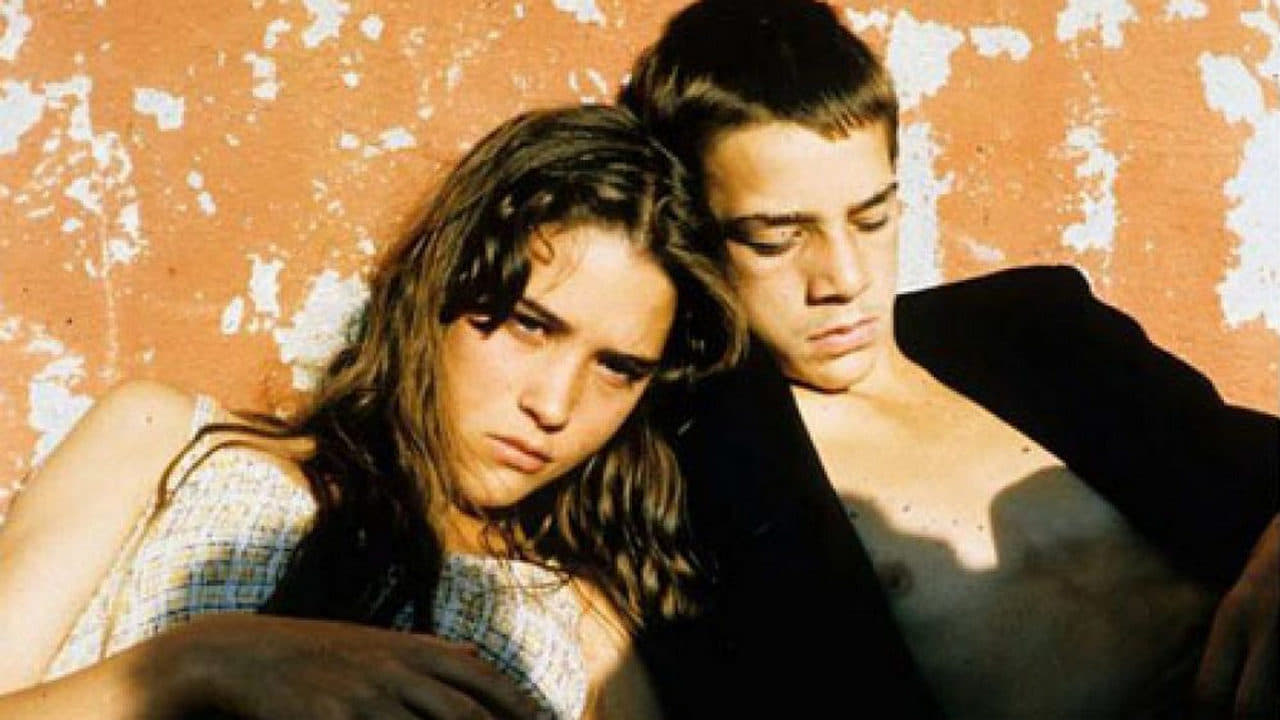lazarillo
This movie kind of fits into this unofficial French genre which might be called the "French-jailbait-on-the-beach" film. This loose genre could include classy Eric Rohmer films like "Claire's Knee" and "Pauline at the Beach", the good but very depressing female coming-of-age films of Catherine Breillat like "36 Fillete" and "A moi souer", as well as enjoyable trash like "L'anne des medusas" (you could even throw "Swimming Pool" in here maybe). This movie is about a homeless teenage French girl who hangs around an American military base as kind of an amateur prostitute (it occurred to me watching this that one reason so many people hate America might be because our military uses the whole world as their whorehouse). She meets up with a psychotic French boy her own age and helps him steal a gun from the base, at which point the plot takes a rather implausible turn into serial murder.This movie is not as sophisticated as a Rohmer film nor is it as squirm-inducingly realistic as a Breillat film. It kind of resembles "L'annee des medusas", but where that movie was exploitative trash from the get-go (featuring a somewhat older and very naked Valerie Kaprisky), this movie tries to be a realistic teenage slice-of-life for awhile but goes seriously off the rails with the serial murder plot. Like a lot of French movies it also suffers from a terminal case of pretentiousness. As with other films of its type, however, it does have some great cinematography of the beautiful Baie des Anges (where is that anyway?). These films would all make great advertisements for France's tourism board--if not for all the scary teenage French girls.
sksjr
The chaos of children running the world is a disturbing and possibly accurate portrayal of these characters' view of the world. Each is stealing, cheating and manipulating to survive, except that they don't know they're not surviving, just wild animals. The American sailors are punks, and it's a crime that they are the closest thing to authority figures in the story. Some characters are just brutal, or maybe a bit flat.Marie is living for the moment, oblivious of her aimlessness. Desperate for love, she knows only sex. Orso, also desperate for love, doesn't know how to get anything without just taking it. Because he equates love with giving things, he returns to his violent nature eventually. Neither of the ill-fated couple are not prepared to succeed. These lead characters are undesirable, but I still loved them with all of their failings. I found the story unsettling and thought provoking.Striking scenery and soulful, well-crafted acting drew me into the film completely. The clear beauty of the land and sea is visually stunning. It makes you want to go and experience it. Marie's gentle, natural beauty and wide eyed innocence (or calm?) are validation of Vahina Giocante as a star. She's the beautiful girl next door, the one you understand and don't understand at the same time, but love to be around. Orso's brooding and watching from a distance absolutely demonstrate Frederic Malgras' understanding of an outcast who finds the one thing he wants most of all. A part of me relates to him. If these two stars have that much range, why aren't they in more films?
Chris Knipp
Manual Pradal said he used 'legendary elements of the Mediterranean' (soccer stadiums, the Grand Prix, the Carnival, American sailors) in this 'stunningly beautiful film,' as Stephen Holden called it when it appeared in 1998. Holden described 'Marie Baie des Anges' as a 'dizzying paganistic ode to Eros, where the camera almost never stops moving.' He and others have pointed out that it's a movie where men in packs seem about to attack, danger comes out of nowhere, scenes on the verge of turning ugly then veer off in another direction. (The danger of carnival may make you think of 'Black Orpheus.') Others have commented that Pradal quotes shamelessly from the French New Wave, and that the classic American sailor types could be right out of Jacques Rivette. They might have mentioned Jean Cocteau, who would have loved the use of motorbikes and cars and recurring threatening figures and swift, dreamlike camera motion, the poetic, operatic plot. They've talked about the timelessness of the story -- it's 1990's, but it could be 1950's. (It's altogether a film out of time, cut off from any period or any taste, and that's one main reason why it's so much misunderstood.) The hedonistic summer lifestyle of the young people, the unspoiled landscapes, and those sailors seem to hark back to some indefinable earlier era. Pradal spoke of employing 'drunken' editing; he cuts back and forth in time with surreal, dreamlike, vertiginous effect.People will always be enchanted by this movie. Others will always dismiss it; not get it. It helps to have grown up in the Fifties (as I did) and to have felt the New Wave as an enchantment and loved the sun baked seasides in the French films of surrounding decades. It also helps to appreciate, as Stephen Holden did, that Pradal's is a French and Mediterranean sensibility -'about as far away as you can get from the icky, coy Hollywood 'primitivism' of 'The Blue Lagoon.' Part of this is that the kids, however attractive, are real kids. They don't lift weights or do aerobics, but they're comfortable with their young bodies. They have the natural grace and style and class of Mediterranean kids at the seashore in the summer. The girl, Marie, is played by Vahina Giocante, then a dancer with the Marseilles Opera. The role of the boy she chooses to run away with, Orso, is played by Frédéric Malgras, a Russian gypsy the director found, as he found most of the young non-actors he used in the movie, among gypsies, at soccer stadiums, in housing projects. (Giocante has been in over half a dozen films since; Malgras, none.) Not only are the young people non-actors; they're also, for a change, as young as they're supposed to be, really 15 or 16 years old.This is a first film. Some find it pretentious, artificial, prurient. I find it classic and beautiful. It never ceases to amaze me how the scenes repeatedly rise to an almost mythic level. There's some of the aching sense of longing you also feel in the opening sequences of Patrice Chéreau's 'L'Homme Blessé (1983),' where Jean-Hugues Anglade achieved a startling, intense debut as the adolescent boy who impulsively runs away from his dreary bourgeois home in breathless search of risky gay sex. There are moments in 'Marie' you would almost swear have come from a film made decades before, except that there was never such a film.There's an edge of tragedy and doomed-ness throughout; there's also an intense physicality, a sense of the beauty of the light, the air, the wind, the water, the natural grace of the young bodies, the danger of sexual risk, thievery: it's all so fresh you can almost taste it. Yes, this is a stunningly beautiful film. The American sailors have a clumsy grace that's classic and evokes old photographs. They're genuine, but somehow dated. They're completely American - their French is authentically makeshift; they're gauche but self-confident. Orso has a brooding, withdrawn quality. His name means bear but he's more like a fox or a greyhound, lean and always running. Marie's a risk-taking temptress, out to defy the rules, to charm men and play with them, to ransom herself for a few hours of pleasure. The young couple's first big summer becomes their idyll and their last fling. All this may sound corny and over-solemn, but it's not when you see it with an open mind. The cinematography and the back-and-forth editing distance and abstract us from emotion and purify the events and turn them into art. 'Marie Baie des Anges' expresses and satisfies a profoundly aesthetic and sensual view of the world as few other movies have ever done. Within its own limited dimensions and brief time span, it's perfect.
Dr Mysterioso
Marie Baie Des Anges, is quite simply, a highly under-rated French art picture. It is one of my favorite films, because of Maneul Pradal's unique way of storytelling, using visuals to convey the piece.No, the plot doesn't really go anywhere. In the last 20 minutes or so, it doesn't even make any sense. But that's the whole point. It's symbolic. It isn't going anywhere because the lives of Marie and Orso aren't going anywhere. They are lost, troubled youth; who's only refuge is each other, and a deserted island off the coast of France.


 AD
AD



